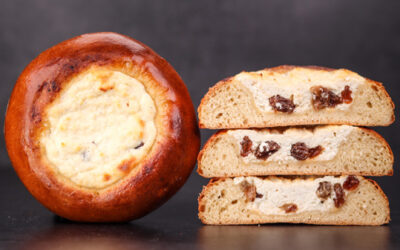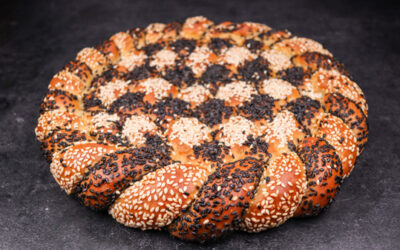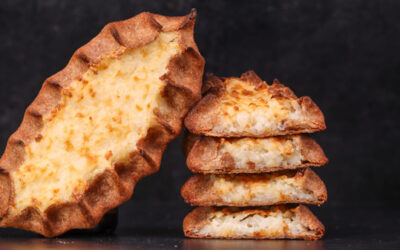This dish is simply awesome. The steamed buns are super soft and fluffy, and the chilli cheese soup is the perfect thing to dip them in and soak up all the deliciousness.
Tingmo are commonly eaten in Tibet and Nepal too, but Bhutan was the first in the alphabet and that is why we will be doing it for Bhutan. The ema datshi on the other hand is Bhutan’s national dish. Ema is chilli and datshi is cheese, so simply put – chilli cheese.
I was a bit sceptical and thought it may be a bit bland at first when I read about this dish, as it seemed so simple. All ingredients are simply boiled together at once and finished with cheese. It takes no more than 10 minutes to cook. It blew my mind once I tasted it. Such a delicious and rich soup with a nice chilli kick. It works so well with the steamed buns as you can use them to soak up the tasty liquid.
In Bhutan they use yak cheese, but you can substitute that with various cheeses. I used some strong cheddar which worked perfectly.
The buns are just as simple and basic as the stew. You can use this dough to make steamed buns with fillings too. Plain ones are good enough for this meal as the soup provides most of the goodness.
The dough will make 4 large buns. If you want to make more simply multiply the amount of ingredients.
Watch the video down below for detailed instructions.
Ingredients
For the dough –
250g (8.8oz) strong white bread flour
3g (0.1oz) instant dry yeast or 3.6g (0.12oz) active dry yeast or 9g (0.3oz) fresh yeast
5g (0.17oz) salt
20g (0.7oz) sugar
20g (0.7oz) vegetable oil
140g (4.9oz) cold water *
*To learn more about dough temperature control click here.
20g (0.7oz) more vegetable oil for the layers
For the chilli cheese soup –
Thinly sliced red onion
Thinly sliced garlic
Chopped spring onions
Diced tomato
Sliced chillies
Salt to taste
Butter
Cheese
Water
I am not giving exact amounts for the soup as this totally depends on your taste and spice tolerance. You can use more or less of either ingredient because it will work regardless. Make it to your own taste.
The only thing to be careful with is the amount of salt as the cheese will make the soup salty too!
Method
- In a large bowl combine the water, yeast, salt, sugar, and oil. Mix well to dissolve any large salt and sugar crystals and to hydrate the yeast. Add the flour and mix to a dough.
- Tip the dough out on your table and knead for around 5 minutes. *Desired dough temperature 25-26C (77-79F). If your dough is warmer, then it will ferment more rapidly. If it is cooler, then it will take longer. Adjust proofing time accordingly.
- Cover and ferment for 1 hour.
- Fold.
- Ferment for 1 more hour.
- Roll the dough out to a large rectangle. Brush with the vegetable oil. Fold up in three layers. Cut the dough into 4 equal pieces. Cut each dough piece into 6 equal strips.
- Place three strips on top of three strips. Grab both ends of the stack and stretch it out. Twist it up. Finally tie the twisted dough around your fingers. The two ends should end up underneath the bun. Try not to have any loose ends visible. Watch the video for a better view on how this should be done.
- Place the buns on pre-cut pieces of non-stick paper. Cover and ferment for 1 – 1.5 hours or until well puffed up. *During the final 15 minutes of fermentation prepare a pot of boiling water and the steamer. It is best to place the buns in a preheated steamer.
- Steam the buns for 12 minutes. My steamer is quite large, but I could only steam two buns at a time as they puff up quite a lot. I kept the remaining buns in the fridge whist the first batch was steaming to prevent them from over proofing.
- Make the chilli soup while the buns are steaming. In a pot combine all the ingredients but the cheese. Bring up to a boil and cook for 10 minutes. Switch the heat off and add the cheese. Let it melt. Lastly stir everything up and it is ready to serve.
Enjoy it all whilst warm and fresh. And check out some more Baking World Tour videos as you are enjoying your meal.
Keep in mind that the conditions in each kitchen are different, so fermentation times may vary for you. It is up to the baker to control the bread and react accordingly.
Watch the video here



